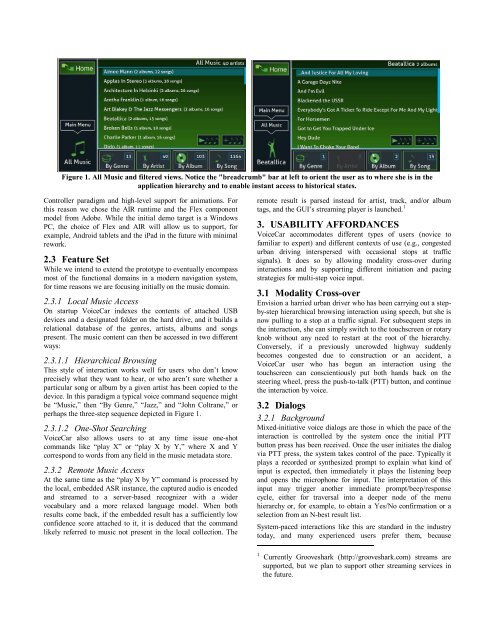Automotive User Interfaces and Interactive Vehicular Applications
Automotive User Interfaces and Interactive Vehicular Applications
Automotive User Interfaces and Interactive Vehicular Applications
Create successful ePaper yourself
Turn your PDF publications into a flip-book with our unique Google optimized e-Paper software.
Figure 1. All Music <strong>and</strong> filtered views. Notice the "breadcrumb" bar at left to orient the user as to where she is in the<br />
application hierarchy <strong>and</strong> to enable instant access to historical states.<br />
Controller paradigm <strong>and</strong> high-level support for animations. For<br />
this reason we chose the AIR runtime <strong>and</strong> the Flex component<br />
model from Adobe. While the initial demo target is a Windows<br />
PC, the choice of Flex <strong>and</strong> AIR will allow us to support, for<br />
example, Android tablets <strong>and</strong> the iPad in the future with minimal<br />
rework.<br />
2.3 Feature Set<br />
While we intend to extend the prototype to eventually encompass<br />
most of the functional domains in a modern navigation system,<br />
for time reasons we are focusing initially on the music domain.<br />
2.3.1 Local Music Access<br />
On startup VoiceCar indexes the contents of attached USB<br />
devices <strong>and</strong> a designated folder on the hard drive, <strong>and</strong> it builds a<br />
relational database of the genres, artists, albums <strong>and</strong> songs<br />
present. The music content can then be accessed in two different<br />
ways:<br />
2.3.1.1 Hierarchical Browsing<br />
This style of interaction works well for users who don’t know<br />
precisely what they want to hear, or who aren’t sure whether a<br />
particular song or album by a given artist has been copied to the<br />
device. In this paradigm a typical voice comm<strong>and</strong> sequence might<br />
be “Music,” then “By Genre,” “Jazz,” <strong>and</strong> “John Coltrane,” or<br />
perhaps the three-step sequence depicted in Figure 1.<br />
2.3.1.2 One-Shot Searching<br />
VoiceCar also allows users to at any time issue one-shot<br />
comm<strong>and</strong>s like “play X” or “play X by Y,” where X <strong>and</strong> Y<br />
correspond to words from any field in the music metadata store.<br />
2.3.2 Remote Music Access<br />
At the same time as the “play X by Y” comm<strong>and</strong> is processed by<br />
the local, embedded ASR instance, the captured audio is encoded<br />
<strong>and</strong> streamed to a server-based recognizer with a wider<br />
vocabulary <strong>and</strong> a more relaxed language model. When both<br />
results come back, if the embedded result has a sufficiently low<br />
confidence score attached to it, it is deduced that the comm<strong>and</strong><br />
likely referred to music not present in the local collection. The<br />
remote result is parsed instead for artist, track, <strong>and</strong>/or album<br />
tags, <strong>and</strong> the GUI’s streaming player is launched. 1<br />
3. USABILITY AFFORDANCES<br />
VoiceCar accommodates different types of users (novice to<br />
familiar to expert) <strong>and</strong> different contexts of use (e.g., congested<br />
urban driving interspersed with occasional stops at traffic<br />
signals). It does so by allowing modality cross-over during<br />
interactions <strong>and</strong> by supporting different initiation <strong>and</strong> pacing<br />
strategies for multi-step voice input.<br />
3.1 Modality Cross-over<br />
Envision a harried urban driver who has been carrying out a stepby-step<br />
hierarchical browsing interaction using speech, but she is<br />
now pulling to a stop at a traffic signal. For subsequent steps in<br />
the interaction, she can simply switch to the touchscreen or rotary<br />
knob without any need to restart at the root of the hierarchy.<br />
Conversely, if a previously uncrowded highway suddenly<br />
becomes congested due to construction or an accident, a<br />
VoiceCar user who has begun an interaction using the<br />
touchscreen can conscientiously put both h<strong>and</strong>s back on the<br />
steering wheel, press the push-to-talk (PTT) button, <strong>and</strong> continue<br />
the interaction by voice.<br />
3.2 Dialogs<br />
3.2.1 Background<br />
Mixed-initiative voice dialogs are those in which the pace of the<br />
interaction is controlled by the system once the initial PTT<br />
button press has been received. Once the user initiates the dialog<br />
via PTT press, the system takes control of the pace. Typically it<br />
plays a recorded or synthesized prompt to explain what kind of<br />
input is expected, then immediately it plays the listening beep<br />
<strong>and</strong> opens the microphone for input. The interpretation of this<br />
input may trigger another immediate prompt/beep/response<br />
cycle, either for traversal into a deeper node of the menu<br />
hierarchy or, for example, to obtain a Yes/No confirmation or a<br />
selection from an N-best result list.<br />
System-paced interactions like this are st<strong>and</strong>ard in the industry<br />
today, <strong>and</strong> many experienced users prefer them, because<br />
1 Currently Grooveshark (http://grooveshark.com) streams are<br />
supported, but we plan to support other streaming services in<br />
the future.





